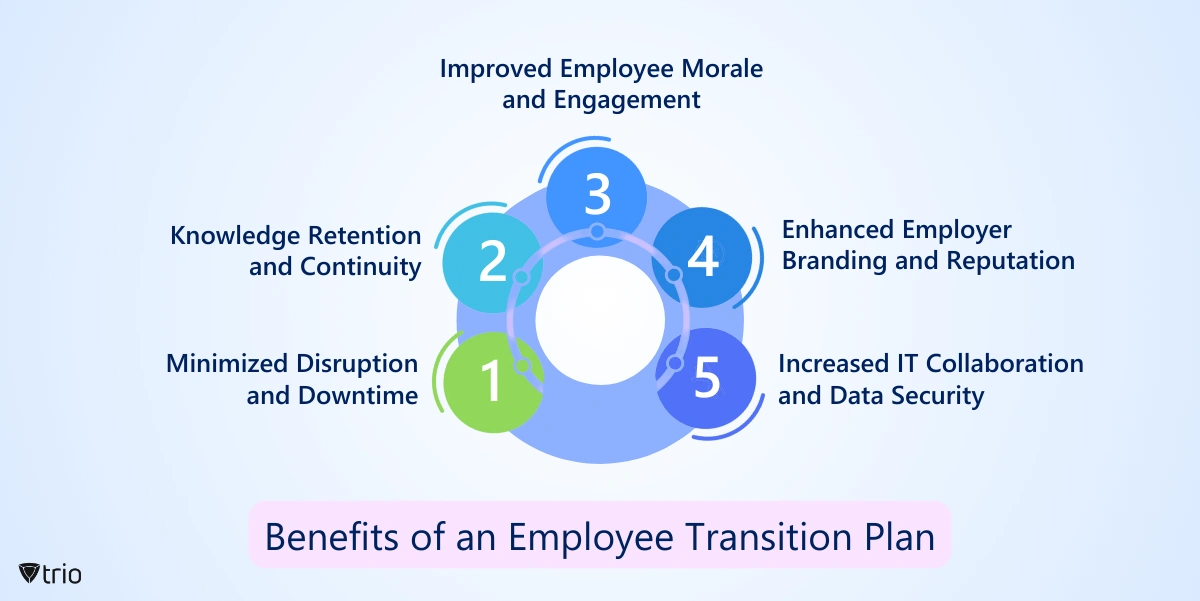Employee turnover is a natural part of any organization’s lifecycle. While departures are inevitable, their impact on your team’s productivity and overall morale can be minimized through strategic planning. A well-crafted employee transition plan acts as a roadmap, ensuring a smooth handover of knowledge and responsibilities during an employee’s departure. This proactive approach mitigates disruption, fosters knowledge retention, and allows for a seamless continuation of critical operations.
This comprehensive guide equips you with the tools and strategies to develop an effective plan. By following these steps, you can ensure a successful knowledge transfer, minimize downtime, and maintain a positive and professional environment throughout the process.
Understanding Employee Transition Plans
Employee departures, planned or unplanned, can throw a wrench into your team’s well-oiled machine. Valuable knowledge walks out the door, projects stall, and morale takes a dip. Here’s where a well-crafted employee transition plan comes to the rescue.
What is an Employee Transition Plan?
An employee transition plan is a proactive strategy that outlines the steps necessary for a smooth handover of roles and responsibilities during an employee’s departure. This can be due to an internal promotion, resignation, retirement, or even a temporary leave of absence. This strategy guides the process from anticipating potential departures to knowledge transfer and finalizing loose ends. It ensures critical operations continue uninterrupted, minimizes disruption to the team, and fosters a positive experience for the departing employee.

Benefits of an Employee Transition Plan
An employee transition plan offers a multitude of advantages for both the departing employee and the organization as a whole. Let’s explore some of the key benefits:
1. Minimized Disruption and Downtime
By planning ahead and outlining clear steps for knowledge transfer, you can significantly reduce disruptions to ongoing projects and workflows. This ensures a smoother handover and shortens the transition period.
2. Knowledge Retention and Continuity
Employee transition plans facilitate the capture and transfer of institutional knowledge. This valuable information, often undocumented, can be easily lost during unplanned departures. A structured plan ensures critical knowledge is documented, shared, and readily accessible to the remaining team members.
3. Improved Employee Morale and Engagement
Uncertainty and disruption can negatively impact team morale. A disorganized transition process can cause chaos in the company and even lead to employee and HR burnout. Conversely, a transparent and well-communicated transition process fosters a sense of security and stability within the team. Perceived as a talent retention strategy, it shows employees that the organization is prepared, making them appreciate the effort invested in minimizing disruption.
4. Enhanced Employer Branding and Reputation
A positive departure experience reflects well on your organization. A seamless transition demonstrates the management team’s commitment to employee well-being and professionalism. This positive experience can enhance your brand and reputation, attracting top talent in the future.
5. Increased IT Collaboration and Data Security
A well-defined employee transition plan fosters IT collaboration within the company. By outlining clear procedures for access revocation, data migration, and system updates during an employee departure, the plan ensures a secure and seamless transition. This collaboration between the departing employee and the remaining IT staff minimizes the risk of data breaches or unauthorized access.

Steps to a Successful Employee Transition Plan
A well-structured employee transition plan empowers you to navigate departures effectively. Here’s a step-by-step guide to creating a transition plan:
Initiate Early
A proactive approach is paramount to a successful employee transition. This includes anticipating potential departures and taking early steps. Here are some key strategies for initiating the process early:
Identify Potential Departures
Regular performance reviews are a valuable tool for gauging employee satisfaction and identifying potential flight risks. During these discussions, encourage open communication about career goals and aspirations. Are employees feeling stagnant or lacking growth opportunities? Addressing these concerns proactively can help retain top talent.
Develop a Talent Pool
Don’t wait for a resignation to scramble for a replacement. Invest in your workforce by creating a talent pool of high-potential employees. Provide opportunities for internal growth and skill development through training programs, mentorship initiatives, and project assignments with increasing responsibility. This not only empowers your employees but also ensures a readily available pool of qualified candidates for future openings.
Implement Cross-Training Initiatives
Knowledge redundancy is key to a resilient team. Encourage cross-training initiatives where team members learn each other’s roles and responsibilities. This not only fosters collaboration but also ensures critical tasks aren’t solely dependent on one individual. In the event of an employee’s departure, the team will be better equipped to handle the workload while a permanent replacement is identified.
Communicate Clearly
Transparency and clear communication are essential ingredients for a successful transition plan for leaving employees. Keeping everyone informed throughout the process fosters trust, minimizes anxiety, and ensures a smoother handover for all parties involved. Here are some key steps to follow:
Promptly Inform the Team
Once an employee’s departure is confirmed, promptly inform the team about the timeline and next steps. This avoids unnecessary speculation and allows the team to begin preparing for the transition.
Maintain Open Communication Channels
Uncertainty breeds anxiety. Throughout the process, maintain open communication channels to address questions and concerns from both the departing employee and the remaining team members. Schedule regular meetings, encourage open dialogue, and be readily available to address any issues that may arise.
Facilitate Knowledge Sharing
Knowledge transfer is a crucial aspect of a successful transition. Facilitate knowledge sharing by encouraging collaboration between the departing employee and their successor(s). This can involve shadowing arrangements, mentorship programs, or collaborative documentation sessions. By actively promoting knowledge transfer, you ensure critical institutional knowledge remains within the organization.
Document Expertise
During an employee departure, a significant challenge lies in capturing and transferring the departing employee’s institutional knowledge. This knowledge, often undocumented and residing in the employee’s mind, is crucial for maintaining operational continuity. A well-structured employee transition plan addresses this challenge by incorporating strategies for effective knowledge transfer. Here are some key methods to consider:
Develop Clear and Comprehensive Documentation
Encourage the departing employee to create clear and comprehensive documentation of processes, procedures, and best practices. This documentation should be readily accessible to the remaining team members and future hires. A comprehensive document containing flowcharts, step-by-step guides, and wikis is a good transition plan example that ensures the information is understandable and easily searchable.
Utilize Knowledge Transfer Techniques
Knowledge transfer goes beyond simply handing over a document. Implement various techniques to facilitate a deeper understanding and retention of knowledge.
- Shadowing: The departing employee can dedicate time to shadowing their successor, allowing them to observe daily tasks and workflows firsthand.
- Mentorship Programs: Formalize knowledge transfer through a mentorship program. This allows for ongoing guidance and support as the successor assumes their new responsibilities.
- Knowledge-Sharing Sessions: Facilitate dedicated sessions where the departing employee can share their expertise with the team through presentations, workshops, or Q&A sessions.
Address Logistical Considerations and Safe Offboarding
A successful employee transition extends beyond knowledge transfer. Safe offboarding practices are crucial for ensuring data security and maintaining regulatory compliance. Here are some key considerations that your planning should include:
Secure Company Property and Access
Upon an employee’s departure, promptly revoke access to company property, including laptops, mobile devices, and physical keys. Reset passwords for all company accounts and systems they previously accessed. This minimizes the risk of unauthorized access to sensitive data or company assets.
Implement Data Security and Safe Offboarding Protocols
Employee departures require careful handling of company data. Implement procedures for data migration or deletion, depending on the nature of the information and your organization’s data retention policies. Consider utilizing a Mobile Device Management (MDM) system to remotely wipe or disable access to company data stored on departing employees’ mobile devices. An MDM can also help enforce strong password policies and data encryption, further decreasing tech risks during offboarding.
Delegate Outstanding Tasks and Responsibilities
Ensure a clean handover of outstanding tasks and responsibilities. Create a clear handover document outlining all pending projects, deadlines, and next steps. This transition plan document serves as a roadmap for the remaining team members to ensure ongoing projects continue uninterrupted. Additionally, using a secure collaboration tool for task delegation can help ensure that this process goes smoothly. For instance, a project management transition plan might delegate tasks like documenting project plans and key contacts, scheduling upcoming milestones, and knowledge transfer to ensure the new project manager inherits a clear roadmap for success.
Conduct Exit Interviews
Exit interviews offer valuable insights into employee motivations for leaving and areas for improvement within your organization. This will positively impact your organization in the long term. Conduct exit interviews in a professional and respectful manner, gathering feedback on company culture, compensation, and career development opportunities.
Conclusion
Employee departures are a natural part of the business cycle. But with a well-thought-out employee transition plan, you can ensure a smooth handover of knowledge, minimize disruption, and maintain team morale. This guide equipped you with the steps to create such a plan, emphasizing clear communication, collaborative knowledge transfer, and continuous improvement.
However, data security remains a concern during offboarding. Trio, a powerful MDM solution, empowers you to address this challenge. Trio allows you to remotely wipe or disable access on departing employees’ devices, enforces strong data security protocols, and streamlines device management.
Ready to experience the power of Trio for yourself? Sign up for a free demo today and discover how Trio can help you navigate employee transitions with confidence.
Know about news
in your inbox
Our newsletter is the perfect way to stay informed about the latest updates,
features, and news related to our mobile device management software.
Subscribe today to stay in the know and get the most out of your mobile
devices with our MDM solution app.
Recent Posts

Erase the Risk: Protect with Zero Standing Privileges
Learn how zero standing privileges eliminate persistent access rights, enhance data security and reduce the risk of unauthorized access.

Understanding Access Control Types in Cybersecurity w/ Examples
Thorough understanding of access control types & the knowledge to make informed decisions about implementing security measures in your organization.

Cloud Data Protection: Safeguarding Information in the Cloud
Learn essential strategies for robust cloud data protection, exploring tools, best practices, and policies that safeguard sensitive information.





